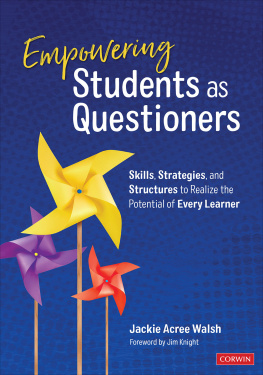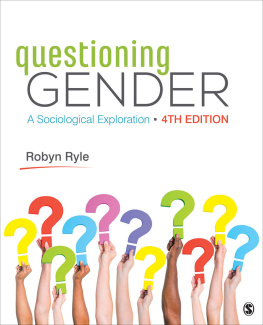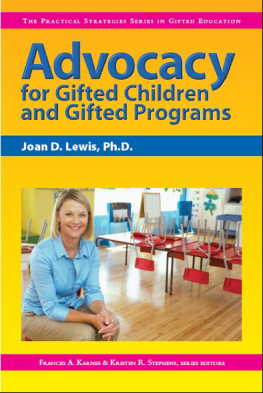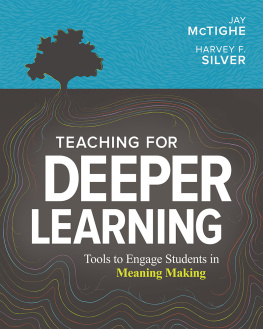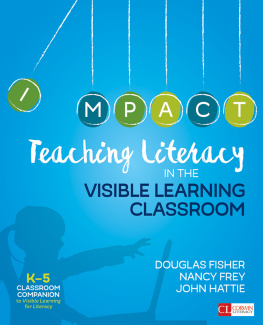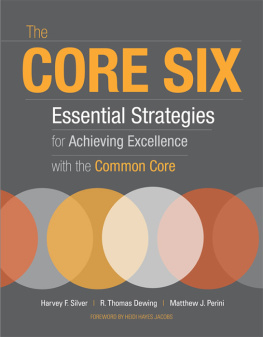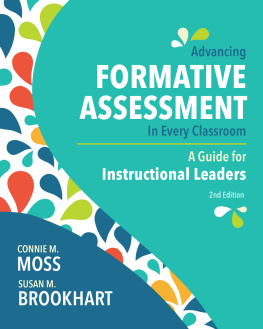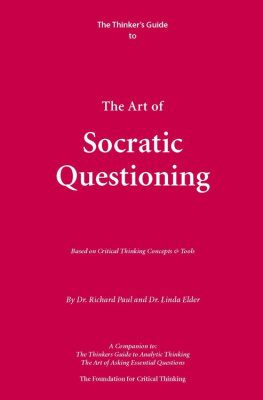Acknowledgments
....................
Countless individuals provided the inspiration, encouragement, and support that enabled us to undertake and complete this project.
Allison Scott, ASCD Acquisitions Editor, encouraged us from the inception to the conclusion of this project. Allison identified the need for a book that would provide a practical approach to developing student skills for discussion. She posed thoughtful questions as we conceptualized the book's framework and provided helpful feedback in early drafts. Not only did she offer wise counsel related to the substance of the book, she was unswerving in her patience and understanding throughout the process.
Cristina Solis, a passionate and deeply committed practitioner, first invited us to design a professional learning experience for administrators focused on the connections between our work in quality questioning and "Questioning and Discussion," indicator 3b in the Danielson Framework for Effective Teaching. Through dialogue with Cristina, we developed new insights that led us to think about the possibility of writing a book such as this. In the midst of writing the book, Cristina provided the opportunity for us to validate the frameworks underpinning this book as we provided professional development to groups of NYC teachers, principals, and instructional coaches. We value Cristina as a thought partner, colleague, and friend.
We share a passion for working with teachers and school leaders in overtime professional learning that focuses on the reflection of questioning practices. Through the years, we have interacted with thousands of educators across the country, and we have learned from the experience and craft knowledge they have shared with us. We are particularly grateful to the teachers whose classrooms are featured throughout this book. Additionally, we acknowledge below the school leaders who enabled us to work with these teachers.
As we were embarking on this project, our work with Sharon Hill, former principal of PS 290, Manhattan New School, and her amazing faculty expanded our understanding of questioning for discussion in the elementary grades. Paige Meloni, executive director of student and academic services, SCUC (TX) ISD, has enabled us to connect with teachers and students in their classroom settings and thereby include a number of their voices in the text. Principal Lisa Berry and her faculty at Hewitt-Trussville Middle School (AL) opened their classrooms and provided videos that served as grist for certain sections of the book. Naomi Isaac-Simpson championed our work in NYC and NJ schools, taking it into classrooms and sharing countless examples of discussion in elementary schools, particularly in math classrooms. Cheryl Altizer, principal at Ansted Elementary in Fayette County (WV), and her staff welcomed us into their school to learn together about ways to engage K5 students in discussion.
We are grateful to the Teaching Channel for their permission to connect to selected videos via the use of QR codes and to the individual teachers whose classrooms are featured in these videos.
All authors stand on the shoulders of thinkers and writers whose work they have read and reflected on over time. We feel particularly indebted to James T. Dillon, professor emeritus at UC Riverside, whose work on questioning and discussion influenced us early on in our work together. Dillon's distinction between questioning in recitation and questioning for discussion continues to drive our thinking.
Carla McClure carefully read our draft manuscript and provided helpful feedback. Carla has served as an important critical friend to us over many years. We value her intellect, wit, and friendship.
Jackie is grateful for the inspiration provided by her children, Catherine and Will, both of whom are extraordinary questioners and facilitators of discussion with university students. She also wishes to acknowledge the intellectual stimulation and moral support provided by a valued colleague, Cathy Gassenheimer, executive vice president for the Alabama Best Practices Center.
Beth is indebted to her mother for first teaching her the value of discussionsaround the dining room tableon a variety of subjects, none ever too controversial. She continues to learn through discussions with her husband, Lyle, and her sons Chris and Michaelall of whom have supported her work, despite the days and hours it has taken her away from home.
Finally, we appreciate Jamie Greene's careful and thoughtful reading and review of the manuscript. As an associate editor with ASCD, he managed the editing and review process in an efficient manner and enhanced the quality of the final product.
Introduction
Making the Case for Questioning for Discussion
....................
Why should we place greater emphasis on questioning for discussion in our classrooms?
Questioning and discussion are important meansand endsof student learning. Research connects student engagement through questioning and discussion to improved learning outcomes, including higher levels of thinking and increases in student achievement (Applebee et al., 2003; Murphy et al., 2009). Furthermore, the skills of questioning and discussion are valuable in and of themselves. Employers report that they are important to career success (Wagner, 2008), college professors tout their value in the academic environment (Conley, 2008; Graff, 2003), and which of us would not agree that discussion and critical thinking skills are keys to active citizenship in our democratic society?
Questioning and discussion work in tandem to move students from passive participants to active meaning makers. Acknowledgment of the interdependent nature of these two skills can be found in the new state standards and in teacher evaluation rubrics. Advocates for an increased focus on questioning and discussion argue that these skills support critical thinking and collaborative problem solving (Schmoker, 2006; Wagner, 2010).
Given the compelling case for the value of questioning for discussion, one might assume that these instructional strategies are used effectively and regularly in K12 classrooms throughout the United States. However, there is substantial research to the contrary: classroom discussion is a rare event in our schools. Perhaps this is one reason for the current emphasis on questioning and discussion in curriculum standards and teacher evaluation systems. Skillful use of questioning for discussion is clearly a classroom practice that is worthy of pursuit.
Questioning and Discussion: Prominent in Learning and Teaching Standards
A signal feature of the Common Core State Standards (CCSS) is the inclusion of speaking and listening alongside reading and writing in the triumvirate of English language arts (ELA)/literacy standards. The underlying logic is that these three skill sets are interdependent and reinforce one another in deepening students' understanding of content. This logic is evident in the first CCSS anchor standard for speaking and listening, which states that students should be able to do the following:
Prepare for and participate effectively in a range of conversations and collaborations with diverse partners, building on others' ideas and expressing their own clearly and persuasively. (ELA-Literacy.CCRA.SL.1)
The conjunction of discussion and questioning appears in the grade-level Common Core standards associated with this anchor, beginning with kindergarten. By the time students are in Grades 1112, they are expected to do the following:


